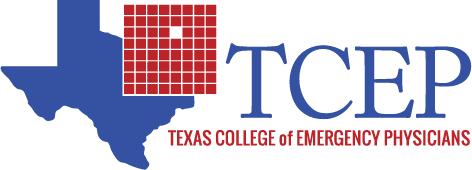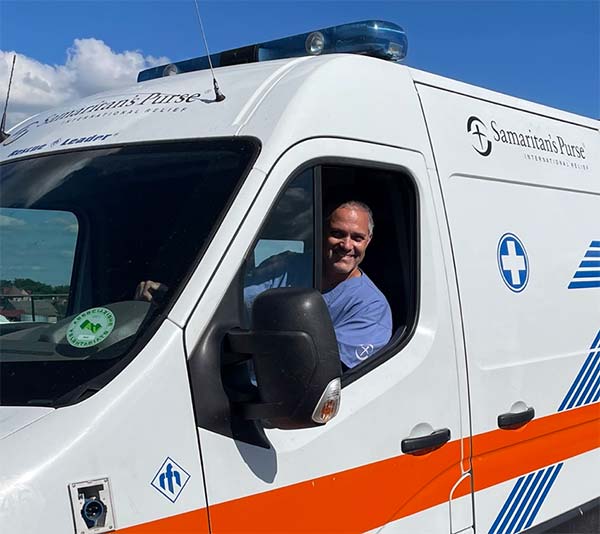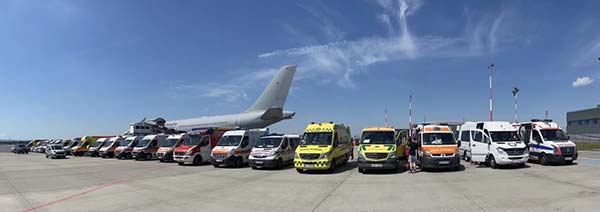TCEP Member Dr. Michael Parsa Serves in the UkraineAugust 2022El Paso ED physician and TCEP member, Michael Parsa, has just returned from serving with Samaritan’s Purse in Ukraine. He is a core faculty member at the Texas Tech-El Paso EM residency. Prior to El Paso, he spent 3 years at Rumginae Hospital in Papua New Guinea.
When the conflict in Ukraine began, Samaritan’s Purse (SP) responded immediately. At the invitation of the Ukrainian Ministry of Health (MoH), they set up an Emergency Field Hospital (EFH) in the west Ukrainian city of Lviv. Lviv has a population of a half million, but with the war, displaced families fled west and at one point 100,000 people a day were arriving in Lviv. The city was overwhelmed and Samaritan’s Purse stepped in to provide mattresses, hygiene, food, water, medical care and other essentials for the internally displaced persons (IDPs). The reason they contacted me as an EM physician was two-fold, to see patients in the EFH and to help them start an EMS transport service requested by the MoH. Although Samaritan’s Purse is meeting essential needs all over the country, including in active conflict zones, their main base of operation is in Lviv, meeting the needs of IDPs. The EFH is loaded on a cargo plane in the US in huge crates, flown to the nearest airport and then loaded on trucks for delivery to its destination. Once it arrives, it can be set up within a day or two. As a tier two EFH, it had one fully functional OR, a two bed ICU, a small inpatient unit and the ED. The EFH functioned to provide medical care to IDPs, although most cases were not true emergencies, we were able to refill medications for IDPs who had left those behind through our robust pharmacy, provide basic medical care and counseling as many were understandably facing significant emotional distress. Many had been trapped in buildings that were under missile attack, they had seen family and neighbors die or suffer devastating injury right in front of them. Some had family members fighting on the front line. I found the courage of the Ukrainian people astounding. Encouraged by President Zelenskyy’s fortitude, Ukrainians have risen to do whatever they can for their country. Nearly every young man I spoke to had signed up for military service and were awaiting a call back. They said the lines at the military recruitment centers are out the door. But there is not enough military equipment or personnel for training to take everyone that is willing to serve. I asked if they were concerned for their safety and they seemed to share the same sentiment, that dying for one’s country is honorable and although they didn’t want to die, they were willing to pay the ultimate price if that was required.
Another need brought forward by the MoH was the need for EMS transport. The hospitals throughout Ukraine were overwhelmed. The EU had offered to take injured patients into their hospitals in other countries, if they could just be taken to an airport in Poland, since the entire country of Ukraine is a no-fly-zone. Samaritan’s Purse quickly sprang into action, purchasing seven used ambulances and retrofitting them with appropriate supplies. One of my jobs was to review protocols and med lists and help the EMS crews from the US, Canada and the UK, to quickly deploy. We did so and began transporting patients within days. My first patient was a man who had been trapped in apartment building rubble as missiles fell from the sky. He had suffered devastating injuries and the local hospital had amputated his left arm, most of the fingers on his right hand and he had an external fixator on his lower leg. We picked him up, along with about 15 other patients, at the municipal hospital and caravanned with the other 15 ambulances to the Polish border. Once across, we travelled to an awaiting plane at the Rzeszow, Poland airport. The plane, a Scandinavian Airlines A319, had the seats removed from the entire right side of the passenger jet. Military stretchers were affixed to the plane interior one high and one low, like bunk beds, from front to back, with nurses, doctors and staff sitting in the adjacent seats. Then they were off, to a hospital in Norway. Flights like this, requiring our transport, which, including the lengthy Poland-Ukraine border crossing, was 5 hours each way, would sometimes happen daily. Our largest transfer was a convoy of 22 ambulances, some with two patients each, to Rzeszow for a massive German military aircraft which took all the patients to hospitals somewhere in Germany. As my three weeks in Ukraine were winding down, SP announced it was closing the EFH within a few days. The IDP numbers in the city were dropping and the need wasn’t there like it once was. They would continue operating the ambulance service out of Lviv, and other needed services, but would place the EFH back into crates and have it on standby. As SP continues relief operations within the country, they will be ready to re-deploy the hospital at a moment’s notice, likely someplace closer to the conflict zone, should the need arise and the MoH request it. I was impressed by SP’s nimbleness in their ability to make these needs assessments and make prompt adjustments, conserving resources while remaining ready to respond. I suspect SP and other agencies will be in Ukraine for quite some time. The needs will continue to change, but will persist, and organizations like SP will be ready. I’m thankful for the opportunity to have served, and for selfless colleagues willing to step up at the last minute and cover my shifts. This was my fifth deployment with Samaritan’s Purse, and I doubt it will be my last. From the battlefields of Iraq, to refugee settlements in Bangladesh, each one is unique and I come away changed for the better every time. |


